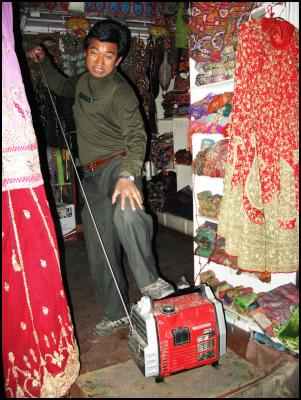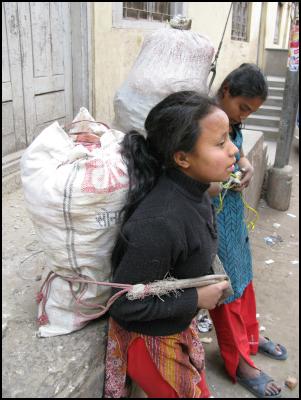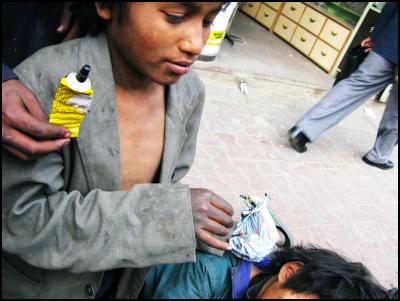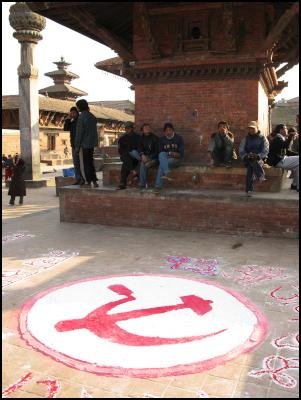Electro-Shock In Kathmandu
Electro-Shock In Kathmandu
by Richard S. Ehrlich
KATHMANDU, Nepal -- When this nation's capital is cut off from electricity, survival becomes a surreal mix of medieval streets lit by candles, people stimulated as if in a Pavlov experiment, and concern that climate change and poverty may doom Kathmandu. If it's Monday, and you are living in Kathmandu's trendy, tourist- packed Thamel neighborhood, take your hot shower and go online before 9 a.m., because this prosperous section of town will not get electricity again until 1 p.m.
Also plan for a blacked-out dinner on Monday evenings, when Thamel's electric supply stops again from 6 p.m. to 9:30 p.m. The next day, stagger your electric needs differently, because on Tuesdays, Thamel's supply stops from 10 a.m. to 2 p.m., and from 8 p.m. to midnight.
Kathmandu's electric "load shedding" schedule changes daily, while rotating throughout the city, making it impossible to do the same things at the same time each day, even in the same neighborhood. As a result, life here evokes comparisons to an experiment by Ivan Pavlov, a 1904 Nobel Prize-winning Russian physiologist who proved dogs salivate when stimulated by the sound of a bell linked to the supply of food.
People in Kathmandu check their calendar and clock before bathing, eating, using computers, watching TV, recharging batteries, refrigerating food and medicine, powering their homes, offices, shops and factories, and doing anything else which requires an electric socket.

Click for big version
Refrigerators frequently go dead in Kathmandu, so some butchers sell meat on tables in the street, hoping people will make their purchases before the animals rot.
The government publishes grid-by-grid calendars warning of the emaciated electricity, which averages six to eight hours off every day, according to which neighborhood you are in.
On one day a week, each zone's supply is kept on.
"Fridays are like a holiday for us because, in this neighborhood, we get electricity for 24 hours on Fridays," a shopkeeper in Thamel said while trying to sell clothing from his small, low-ceiling shop. Another merchant, when asked about the problem of no electricity, silently replied by gesturing with his hand, as if slitting his throat. Wealthier homes, businesses, hotels, restaurants, embassies, offices, factories and hospitals install gasoline-powered generators to provide electricity every time the energy is cut.

Click for big version
A glum merchant uses a single candle to illuminate her small shop in Kathmandu during an electricity cut.
The generators moan like motorcycle engines, and their nauseating, blackish-blue exhaust fumes pollute nearby sidewalks. For many of those buildings, the generators support only emergency lighting while sacrificing most other needs, leaving inhabitants to suffer a slew of deadened services.

Click for big version
A man yanks a rope to start up a gasoline-powered Honda generator, to create electricity inside his cloth shop in Kathmandu.
Those lucky enough to have a generator must also pay the spiraling cost of gasoline.
Kathmandu may serve as an example for Earth's other cities, which are worried about the punishing effects of climate change. Some critics of Nepal's energy problems point north to the snow- covered Himalayas. They speculate that this season's electricity shortage may have been worsened by a recent burst of unusual cold weather, which inhibited the mountains' glaciers from thawing.
Melting snows are supposed to nourish Nepal's rivers and crank up the country's hydro-electric power plants.
During January and February, however, icy weather gripped the Himalayas, thanks to deadly cold fronts which caused havoc across northern Afghanistan, Tibet and much of China.
Severe snows paralyzed China's trains, planes and other traffic, and also hurled freezing wind south across the Himalayas near Mt. Everest, which straddles the border between Nepal and China's Tibet. Other climate watchers say Kathmandu's problem is actually due to global warming because, during recent years, the Himalayas' glaciers have shrunk.
Either way, whatever water does flow from Nepal's mountains, it is now not enough.
Kathmandu has suffered electricity shortages for several years, and also has itself to blame for its lack of sufficient energy. During the past few decades, Kathmandu has experienced a real estate boom, aggravated by an exponential population increase, and poor planning.
Kathmandu's ancient Hindu pagodas, temples, and shrines now compete with new slabs of cement apartments, shops and other buildings -- all straining the city's creaking energy supply. The government is trying to import more electricity from India, while planning to build additional hydro-electric stations in Nepal. But when the power fails, people have little choice except to pay extra for whatever goods and services they can scrounge. Each night, people in shops, homes and other places hurriedly light candles, but the tiny glowing flames do little to illuminate Kathmandu's medieval ambiance.

Click for big version
Many people in Kathmandu do laborious work normally performed by machines, including the transportation of heavy loads, because of poverty and a lack of inexpensive energy to power vehicles.

Click for big
version
A lack of electricity means Kathmandu is
unable to correct many of the city's problems, or provide
opportunities for people to thrive, resulting in scenes such
as this one where a group of street children openly sniff
glue on busy New Road while pedestrians walk
by.

Click for big
version
Maoists, including this group of young men,
are scheduled to compete against other political parties
in a nationwide election in April, but whoever wins will
face problems fixing Nepal's energy
woes.
Richard S Ehrlich is a Bangkok-based journalist who has reported news from Asia since 1978. He is co-author of "Hello My Big Big Honey!", a non-fiction book of investigative journalism, and his web page is http://www.geocities.com/asia_correspondent
Photos © by Richard S. Ehrlich


 Eugene Doyle: The West’s War On Iran
Eugene Doyle: The West’s War On Iran Richard S. Ehrlich: Deadly Border Feud Between Thailand & Cambodia
Richard S. Ehrlich: Deadly Border Feud Between Thailand & Cambodia Gordon Campbell: On Free Speech And Anti-Semitism
Gordon Campbell: On Free Speech And Anti-Semitism Ian Powell: The Disgrace Of The Hospice Care Funding Scandal
Ian Powell: The Disgrace Of The Hospice Care Funding Scandal Binoy Kampmark: Catching Israel Out - Gaza And The Madleen “Selfie” Protest
Binoy Kampmark: Catching Israel Out - Gaza And The Madleen “Selfie” Protest Ramzy Baroud: Gaza's 'Humanitarian' Façade - A Deceptive Ploy Unravels
Ramzy Baroud: Gaza's 'Humanitarian' Façade - A Deceptive Ploy Unravels